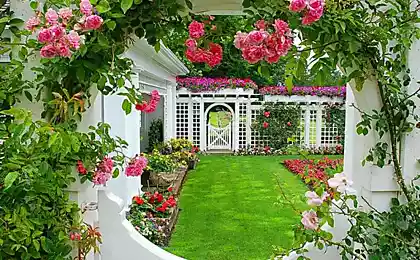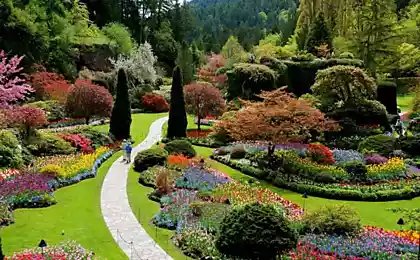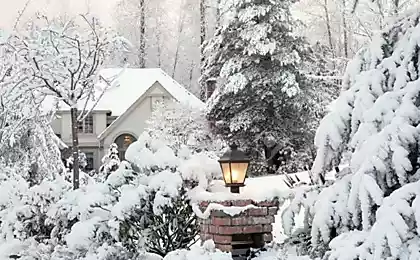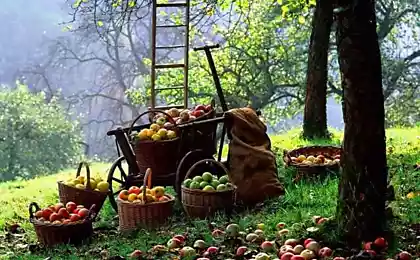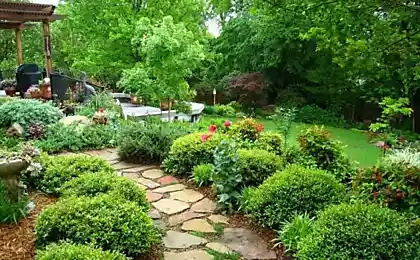570
Clematis in Your garden
He is able to go on the site and the wall of the house, and the flowerbed. He will bring down on you an avalanche of bright flowers and will not leave any heart indifferent. Spectacular clematis is incredibly beautiful, unpretentious and also a constant — a real master of the garden.
Clematis, or clematis, are simply doomed to success among the lovers of the beautiful. Once seen, it is impossible not to fall in love with a gorgeous scattering of flowers, which, defying all traditional norms of beauty number per 1 sq. m., pleasing to the eye from late spring to autumn.

Classification of clematis by the time sitenizdeki the clematis come in many different shades (two-tone), forms (like saucers, stars, bells) and splendor (gustomahrovye, double, semi-double and simple). In addition, different species appear in the outfit at different times — it is by this criterion all representatives lithe and graceful star of the family can be divided into three groups:
The first group includes species clematis and their cultivars, flowering in may — June. This is the Alpine clematis (Clematis alpina), mountain K. (Clematis montana), and K. croproperty (Clematis macropetala). The second group of the selected vines, which demonstrate the floral riot of twice a year — at the beginning and at the end of the summer. The members of this "gang" the "compound" (not a coincidence these include most hybrid clematis): in June they may have double flowers, and in August — semi-double or simple. As for the third group, here are concentrated the large-flowered hybrids, C. teksanski (Clematis texensis), small-flowered varieties K. purple (Clematis viticella), K. East (Clematis orientalis) and K. electricty (Clematis serratifolia). These tireless beauties bloom continuously in July — August. Imagine it is the accuracy of the classification depends on the "dress up" your Pets in luxury decoration next year. Why? Yes, because for each group the most important rule of the procedure — trimming!

2. The mountain clematis (C. montana) 'Marjorie' can "climb" up to a height of 12 m. In July, he conquers flowers of unusual colors.

3. Purple clematis (C. viticella) ‘Minuet’ in bloom from July until September and is suitable for growing in a tub.

4. Jackman of clematis (C. jackmanii) ‘Tie Dye’ is allocated mottled purple-white flowers.

5. Clematis electricty (C. serratifolia) ‘Golden Tiara’ is a variety with Golden-yellow flowers an unusual structure.

6. Purple clematis (C. viticella) ‘Purpurea Plena Elegans’ has gustomahrovye dark red flowers that appear on the vine from July to October.

7. Teksanski clematis (C. texensis) ‘Etoile Rose’ — height is 2.2 m with small bells flowers that bloom in June and again in September.

8. Floriferous clematis (C. florida) ‘Viennetta’ in cold regions for the winter to hide, however when you see its stunning flowers, you know that the efforts are worth it.
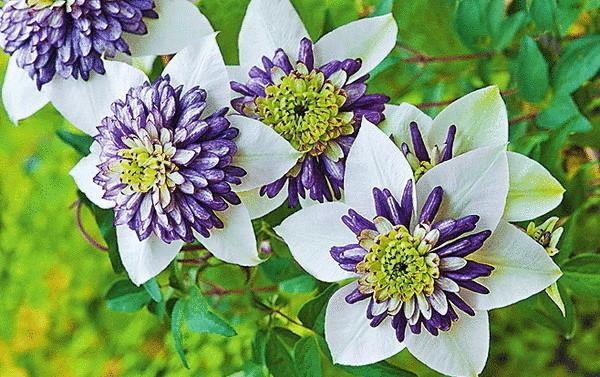
9. Clematis repens (C. repens) is a fast — growing vine with small bright yellow flowers.

10. Clematis hybrid (C. hybrid) ‘Dancing Queen’ captures Terry pale pink flowers, which bloom twice a year — in June and in August.

11. Croproperty clematis (C. macropetala) ‘Purple Spider’ grows up to 3.2 m high and blooms twice — in may-June and August-September.

These clematis species and cultivars even after flowering incredibly decorative as they are decorated with flashy silky silvery fruits: many achenes with short or long haired fleecy columns and "beaks", gathered in a fluffy head. Seeds of clematis carries the wind — it was for the best volatility and they got "fur tails". Look especially beautiful fruit blooming from July to September clematis Tangut (Clematis tangutica, left), and revealing the buds in early summer with Alpine clematis (Clematis alpina) and clematis vitalba (Clematis vitalba).

Cute fruits-pussies not only look spectacular in the garden — they are perfect addition in bouquets and compositions of flowers and fruit plants.

Clematis in the garden ‘Madame Julia Correvon’ — a purple clematis (Clematis viticella). Undemanding to the place of origin, except for one thing: he doesn't like all day to stay in the shade. Its pink-red flowers in perfect harmony with the white rose ‘Ilse Krohn’.

Rose and clematis are considered to be the perfect couple. In the photo to a blooming purple clematis ‘Etoile Violette’ clung delicate rose. And their "legs" spreading fishnet geranium.

‘Nelly Moser’ — shade-tolerant large-flowered clematis hybrid. In the photo he flaunts paired with evergreen variegated Euonymus.

Wooden fence clematis fergusion (fargesioides Clematis) ‘Paul Farges’ with small fragrant flowers. The plant forms a whip length of 4 m and grows well in sun or partial shade. Evening primrose with bright yellow flowers — a great partner for him.

Suitable for the flower garden a clematis. "Sunset" grows to a maximum dot 2.5 m tall and only 90 cm wide, so "it remains enough space for boxwood, sage steppe and Mac.

Clematis ‘Piilu’ grows well in a tub. It complements the Manchurian clematis ‘Juuli’ and variegated Boudreau.

Low column with a stone ball beautifully entwining clematis. For such purposes suitable vines are dwarf varieties such as ‘Mikelite’, ‘Stasik’ or ‘Westerplatte’.
Caring for clematis
In terms of daily care of our hero can be safely put on the honor roll — he doesn't cause too much trouble. Choose a bright, lightly shaded, wind-protected place. The ideal soil is a fertile clay or loamy with neutral or slightly alkaline reaction.
Liana loves moisture, so water it once a week (in the heat 2-3 times). Fertilizing — 4 times per season: alternate mineral fertilizers with organic.
Although clematis and cold, in the winter they need to cover. Irreparable harm in the harsh time they deals not so much frost, as waterlogging of the soil in combination with sudden changes in temperature. The ice can tear the roots and damage the center bushing — that's why in November, the vine must be removed from the support and cover with dry earth, peat, or dense non-woven material.
Important: "raskatyvaete" in the spring the plant gradually, leaving the ground until the threat of late frosts.published
P. S. And remember, only by changing their consumption — together we change the world! ©
Source: www.7dach.ru
Clematis, or clematis, are simply doomed to success among the lovers of the beautiful. Once seen, it is impossible not to fall in love with a gorgeous scattering of flowers, which, defying all traditional norms of beauty number per 1 sq. m., pleasing to the eye from late spring to autumn.

Classification of clematis by the time sitenizdeki the clematis come in many different shades (two-tone), forms (like saucers, stars, bells) and splendor (gustomahrovye, double, semi-double and simple). In addition, different species appear in the outfit at different times — it is by this criterion all representatives lithe and graceful star of the family can be divided into three groups:
The first group includes species clematis and their cultivars, flowering in may — June. This is the Alpine clematis (Clematis alpina), mountain K. (Clematis montana), and K. croproperty (Clematis macropetala). The second group of the selected vines, which demonstrate the floral riot of twice a year — at the beginning and at the end of the summer. The members of this "gang" the "compound" (not a coincidence these include most hybrid clematis): in June they may have double flowers, and in August — semi-double or simple. As for the third group, here are concentrated the large-flowered hybrids, C. teksanski (Clematis texensis), small-flowered varieties K. purple (Clematis viticella), K. East (Clematis orientalis) and K. electricty (Clematis serratifolia). These tireless beauties bloom continuously in July — August. Imagine it is the accuracy of the classification depends on the "dress up" your Pets in luxury decoration next year. Why? Yes, because for each group the most important rule of the procedure — trimming!
- The first group clematis bloom on the shoots of last year, so vines shorten 20-50 cm immediately after flowering to stimulate growth of new shoots.
- Representatives of the second group flowers appear for the first time at last year's whip, the second — on the gains of the current year. The vines pruned in the autumn, shortening the whip to half the length — this ensures a proportionate flowering in both period. To prevent exposure of the lashes in the lower parts, every 4-5 years the plants should be cut almost to the ground.
- The vines of the third group of flower buds form on shoots of the current year, therefore, data "Pets" in the autumn should be severely cut, shortening the whip to 10-30 cm above soil level. Similarly, shear and herbaceous clematis (C. Manchurian — C. integrifilia, direct K. — C. recta).

2. The mountain clematis (C. montana) 'Marjorie' can "climb" up to a height of 12 m. In July, he conquers flowers of unusual colors.

3. Purple clematis (C. viticella) ‘Minuet’ in bloom from July until September and is suitable for growing in a tub.

4. Jackman of clematis (C. jackmanii) ‘Tie Dye’ is allocated mottled purple-white flowers.

5. Clematis electricty (C. serratifolia) ‘Golden Tiara’ is a variety with Golden-yellow flowers an unusual structure.

6. Purple clematis (C. viticella) ‘Purpurea Plena Elegans’ has gustomahrovye dark red flowers that appear on the vine from July to October.

7. Teksanski clematis (C. texensis) ‘Etoile Rose’ — height is 2.2 m with small bells flowers that bloom in June and again in September.

8. Floriferous clematis (C. florida) ‘Viennetta’ in cold regions for the winter to hide, however when you see its stunning flowers, you know that the efforts are worth it.

9. Clematis repens (C. repens) is a fast — growing vine with small bright yellow flowers.

10. Clematis hybrid (C. hybrid) ‘Dancing Queen’ captures Terry pale pink flowers, which bloom twice a year — in June and in August.

11. Croproperty clematis (C. macropetala) ‘Purple Spider’ grows up to 3.2 m high and blooms twice — in may-June and August-September.

These clematis species and cultivars even after flowering incredibly decorative as they are decorated with flashy silky silvery fruits: many achenes with short or long haired fleecy columns and "beaks", gathered in a fluffy head. Seeds of clematis carries the wind — it was for the best volatility and they got "fur tails". Look especially beautiful fruit blooming from July to September clematis Tangut (Clematis tangutica, left), and revealing the buds in early summer with Alpine clematis (Clematis alpina) and clematis vitalba (Clematis vitalba).

Cute fruits-pussies not only look spectacular in the garden — they are perfect addition in bouquets and compositions of flowers and fruit plants.

Clematis in the garden ‘Madame Julia Correvon’ — a purple clematis (Clematis viticella). Undemanding to the place of origin, except for one thing: he doesn't like all day to stay in the shade. Its pink-red flowers in perfect harmony with the white rose ‘Ilse Krohn’.

Rose and clematis are considered to be the perfect couple. In the photo to a blooming purple clematis ‘Etoile Violette’ clung delicate rose. And their "legs" spreading fishnet geranium.

‘Nelly Moser’ — shade-tolerant large-flowered clematis hybrid. In the photo he flaunts paired with evergreen variegated Euonymus.

Wooden fence clematis fergusion (fargesioides Clematis) ‘Paul Farges’ with small fragrant flowers. The plant forms a whip length of 4 m and grows well in sun or partial shade. Evening primrose with bright yellow flowers — a great partner for him.

Suitable for the flower garden a clematis. "Sunset" grows to a maximum dot 2.5 m tall and only 90 cm wide, so "it remains enough space for boxwood, sage steppe and Mac.

Clematis ‘Piilu’ grows well in a tub. It complements the Manchurian clematis ‘Juuli’ and variegated Boudreau.

Low column with a stone ball beautifully entwining clematis. For such purposes suitable vines are dwarf varieties such as ‘Mikelite’, ‘Stasik’ or ‘Westerplatte’.
Caring for clematis
In terms of daily care of our hero can be safely put on the honor roll — he doesn't cause too much trouble. Choose a bright, lightly shaded, wind-protected place. The ideal soil is a fertile clay or loamy with neutral or slightly alkaline reaction.
Liana loves moisture, so water it once a week (in the heat 2-3 times). Fertilizing — 4 times per season: alternate mineral fertilizers with organic.
Although clematis and cold, in the winter they need to cover. Irreparable harm in the harsh time they deals not so much frost, as waterlogging of the soil in combination with sudden changes in temperature. The ice can tear the roots and damage the center bushing — that's why in November, the vine must be removed from the support and cover with dry earth, peat, or dense non-woven material.
Important: "raskatyvaete" in the spring the plant gradually, leaving the ground until the threat of late frosts.published
P. S. And remember, only by changing their consumption — together we change the world! ©
Source: www.7dach.ru





